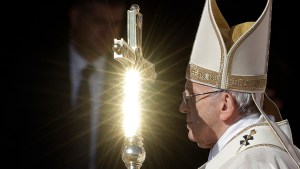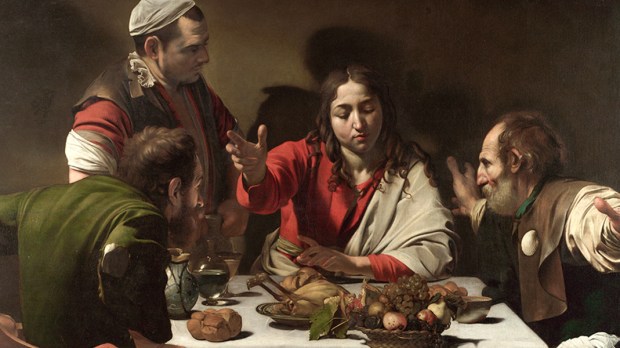Yesterday, after a long, long Lent meditating on the Passion and death of Jesus, we finally celebrated his Resurrection. We sang the Gloria and a thousand alleluias and greeted each other, “He is risen!” The lilies proclaimed his resurrection, the music proclaimed his resurrection, the homily, the liturgy, even our clothes cried out, “Jesus Christ is risen today!”
The only thing that didn’t, really, was the Gospel.
It doesn’t. Not on Easter Sunday. Nor at the Vigil except once every three years. Next year we’ll watch the women encounter the risen Christ at the Easter Vigil, but that only for a moment. On Easter, our Gospel readings don’t show us his glorified body. They show us the empty tomb.
We expect it to be enough, we who have used the empty tomb as a proof of the resurrection. But it wasn’t. Mary Magdalene saw the empty tomb and assumed Jesus’ body had been stolen. The holy women were bewildered by it all, even when an angel told them that the Lord had risen, and the apostles to whom they reported thought the story seemed like nonsense.
It’s baffling to us that they could hear Jesus foretell his resurrection and see the empty tomb and still not believe. But repeatedly, we’re told that they wondered what “rising from the dead” could mean. It was a common debate among Jews of the time, with Pharisees asserting that the soul lived on after death and Sadducees insisting that death was the end. Surely Jesus must merely be taking the Pharisees’ side, promising that he would dwell with the Father forever or live on in their hearts after his death. It seems that the followers of Jesus had no idea that Good Friday wasn’t the end, that death would be destroyed and life remade in that tomb.
When Peter and John went in, they saw the burial cloths rolled up, and knew the body hadn’t been stolen. They believed, we’re told, though John follows this statement by telling us that they still didn’t understand the Scriptures that said Jesus would rise from the dead. What exactly did they believe?
This is where the Church leaves us on Easter Sunday: with an empty tomb and a divided community, some bewildered, some doubtful, some believing but confused, some heading for the hills, not knowing what to think.
It would be a messy end to the story if it were the end. But Easter Sunday is just the beginning of the Easter season, the first encounter with the story of the resurrection. Later this season, we’ll see how people reacted when they met the risen Christ face to face, when they spoke with him and ate with him and touched his glorified wounds.
For now, though, we see what happens when people only know the story of the resurrection, when they know in theory that Jesus has risen from the dead but they haven’t yet encountered him. It’s not enough. Evidence and apologetics and reports of miracles aren’t enough. It’s not even enough to point to the testimony of the endurance of the Church, of which Hilaire Belloc says that “no merely human institution conducted with such knavish imbecility would have lasted a fortnight.” Only a personal encounter with the risen Christ leads to a relationship with Jesus that transforms the empty tomb from a curiosity to an earth-shattering miracle.

Read more:
Pope gives 2 steps to really knowing Jesus
This is why the Church invites us to enter into the other post-resurrection accounts in the weeks after Easter, to read of how Mary Magdalene clung to him and Cleopas recognized him in the breaking of the bread and Peter hung his head in shame. When we pray with those stories, not merely reading them but meditating on them, we begin to get a taste of what it is to know Jesus as more than a theory, as lover and savior and Lord.
This practice, of praying deeply through these Easter stories, is useful not just for encountering Jesus for the first time, but also for inviting him to transform the tombs in our lives. Many of us may have been walking with the Lord for decades, but there’s a grief or a shame or a fear that we haven’t yet handed over to the Lord, an area where we’re still living that early Easter morning uncertainty. God may be working to transform our suffering into glory, but we haven’t yet allowed him to step into our lives and show us his resurrection in the darkest corners of our hearts.
This Easter, don’t leave it at this. Don’t glance at the empty tomb and go home. Look for the risen Lord, seek him in the stories of those who looked upon his glorified body.
There are seven weeks in the Easter season and seven Gospel encounters with the risen Christ. Consider praying through one each week, putting yourself in the story and asking the Lord to be more than just a theory in your life.
Read more:
Pope Francis: Faith is not a philosophy, but an encounter with Jesus Christ

